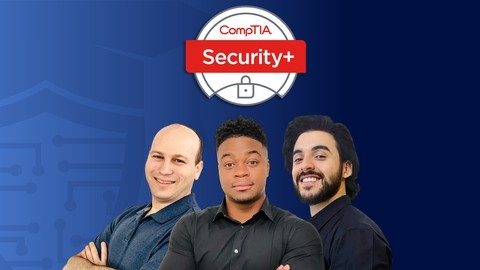Cybersecurity is an increasingly critical field, encompassing the protection of digital information and systems from unauthorized access, use, disclosure, disruption, modification, or destruction.
As businesses and individuals become more reliant on technology, the demand for skilled cybersecurity professionals continues to grow.
Learning cybersecurity can equip you with the knowledge and skills to protect yourself, your organization, and sensitive information from cyber threats.
Finding a high-quality cybersecurity course on Udemy that truly delivers on its promises can be a daunting task.
With so many options available, it’s easy to feel overwhelmed and unsure where to start.
You’re looking for a course that goes beyond theory, providing practical experience and hands-on projects to solidify your understanding.
We’ve reviewed countless courses and based on our analysis, Learn Ethical Hacking From Scratch is the best course on Udemy overall.
This comprehensive course covers a wide range of topics, from the basics of hacking and penetration testing to advanced techniques like network hacking, website hacking, and gaining remote access to systems.
It features practical exercises and real-world examples, making it an excellent choice for both beginners and those with some experience in the field.
While this is our top pick, there are other great options available.
Keep reading for more recommendations for beginners, intermediate learners, and experts, as well as courses focusing on specific cybersecurity topics and tools.
Learn Ethical Hacking From Scratch
This course covers a wide range of topics, from the basics of hacking and penetration testing to advanced techniques like network hacking, website hacking, and gaining remote access to systems.
The course starts with an introduction to ethical hacking, explaining the different types of hackers (white hat, grey hat, and black hat) and the career opportunities in this field.
It then guides you through setting up a hacking lab with multiple operating systems, including Kali Linux, which is the primary hacking platform used throughout the course.
One of the standout sections is network hacking, where you’ll learn how to crack WEP, WPA, and WPA2 wireless encryption, perform packet sniffing, and launch deauthentication attacks to disconnect devices from networks.
The course also covers man-in-the-middle (MITM) attacks, such as ARP poisoning, DNS spoofing, and injecting JavaScript code into target browsers.
Website hacking is another crucial aspect covered in the course.
You’ll learn how to gather information about a target website, discover vulnerabilities like file upload, code execution, SQL injection, and cross-site scripting (XSS), and exploit them to gain access to the website’s server.
The course even teaches you how to use OWASP ZAP to automatically scan websites for vulnerabilities.
Gaining remote access to computers is a significant part of the course, covering both server-side and client-side attacks.
You’ll learn how to use tools like Metasploit and Veil Framework to exploit vulnerabilities and create undetectable backdoors.
Social engineering techniques, such as spoofing emails and creating trojans disguised as innocuous files, are also covered in detail.
It also covers post-exploitation techniques, allowing you to maintain access to compromised systems, capture keystrokes, take screenshots, and even pivot to other systems on the network.
Throughout the course, you’ll learn how to use various tools and frameworks, including Wireshark, Bettercap, BeEF, Maltego, and Nexpose, among others.
The lectures are well-structured, with practical examples and hands-on exercises to reinforce your understanding.
One of the standout features of this course is its emphasis on ethical hacking and responsible disclosure.
It teaches you how to detect and prevent the attacks you’ve learned, ensuring that you use your newfound knowledge responsibly and ethically.
CompTIA Security+ (SY0-701) Complete Course & Exam
This course covers a wide range of cybersecurity topics, from fundamentals to advanced concepts, ensuring you gain the knowledge and skills required to become a certified security professional.
The syllabus is divided into several chapters, each focusing on a specific domain of the Security+ exam objectives.
It starts with an introduction to security fundamentals, including threats, vulnerabilities, and security controls.
You’ll learn about the CIA triad (Confidentiality, Integrity, and Availability) and other essential security principles.
The course then delves into various threat actors, their motivations, and attributes, helping you understand the potential risks and how to mitigate them.
You’ll explore physical security measures, social engineering techniques, and different types of malware, equipping you with the knowledge to identify and prevent these threats.
Data protection is a crucial aspect covered in the course, where you’ll learn about data classifications, ownership, and sovereignty.
You’ll also gain insights into cryptographic solutions, including symmetric and asymmetric encryption algorithms, hashing, and Public Key Infrastructure (PKI).
Risk management is another essential topic, covering risk assessment, analysis, and mitigation strategies.
The course also addresses third-party vendor risks, supply chain attacks, and vendor assessment processes.
Governance and compliance are covered in detail, including policies, standards, procedures, and the consequences of non-compliance.
You’ll learn about asset and change management, audits, assessments, and penetration testing techniques.
The course explores cyber resilience and redundancy, covering high availability, data redundancy, RAID configurations, capacity planning, and backup strategies.
Security architecture, including on-premise and cloud environments, virtualization, containerization, and microservices, is also discussed.
Security infrastructure, such as firewalls, Intrusion Detection and Prevention Systems (IDS/IPS), and network appliances, is covered in-depth.
You’ll learn about Identity and Access Management (IAM) solutions, including multifactor authentication, Single Sign-On (SSO), and access control models.
Vulnerabilities, attacks, and malicious activities are thoroughly explored, covering hardware vulnerabilities, SQL and XML injections, buffer overflows, Distributed Denial of Service (DDoS) attacks, and more.
The course also covers hardening techniques, such as changing default configurations, restricting applications, and applying updates and patches.
Security techniques like wireless infrastructure security, Network Access Control (NAC), web and DNS filtering, and Endpoint Detection and Response (EDR) are also covered.
Vulnerability management, including identifying, analyzing, and remediating vulnerabilities, is another important topic.
The course covers alerting and monitoring, including Security Information and Event Management (SIEM), Simple Network Management Protocol (SNMP), and NetFlow analysis.
Incident response processes, threat hunting, digital forensics, and data collection procedures are also discussed.
Investigating an incident is a crucial aspect, where you’ll learn about analyzing data from various sources, such as dashboards, vulnerability scans, packet captures, and logs.
Automation and orchestration, including automating support tickets, onboarding, security, and application development, are also covered.
Finally, the course emphasizes the importance of security awareness, covering topics like recognizing insider threats, password management, avoiding social engineering, and creating a culture of security.
The syllabus concludes with a comprehensive practice exam, simulating the actual CompTIA Security+ (SY0-701) exam, ensuring you’re well-prepared to take and pass the certification exam.
Risk Management for Cybersecurity and IT Managers
You’ll start with an introduction to the fundamental concepts of risk, including its three core components: assets, vulnerabilities, and threats.
The course dives deep into the various types of risks businesses face and the different kinds of threats targeting our networks.
It even dissects a real-world case study of the Amazon Web Services outage in 2017 to illustrate the consequences of failed risk management.
It equips you with practical strategies to tackle risks head-on.
You’ll learn about the four primary risk responses: mitigation, transference, avoidance, and acceptance.
The syllabus covers risk controls and additional responses drawn from project management methodologies like PMP and PRINCE2.
Calculating risk is a crucial aspect, and the course dedicates sections to both qualitative and quantitative risk measurement techniques.
It even analyzes the infamous Equifax data breach as a case study, examining the management decisions that could have prevented it.
What sets this course apart is its real-world perspective.
You’ll gain insights from industry professionals across government, defense, commercial, and healthcare sectors.
Interviews with experts like Randy Fuller (government), Corey Charles (vulnerability management), David Anderson (healthcare provider), and Tu Laniyonu (insider threat) offer invaluable on-the-ground experiences.
By the end, you’ll have a comprehensive understanding of risk management principles and their practical applications in various domains.
The Complete Certified in Cybersecurity (CC) course ISC2 ‘24
The course is structured into five domains, aligning with the CC exam blueprint.
Domain 1 lays a solid foundation by covering security principles like the CIA triad, IAAA model, risk management, and access control concepts.
You’ll gain a deep understanding of confidentiality, integrity, availability, authentication, non-repudiation, and privacy.
Domain 2 focuses on business continuity, disaster recovery, and incident response.
You’ll learn how to develop robust business continuity plans, disaster recovery strategies, and effective incident management processes.
This domain equips you with the skills to maintain organizational resilience and minimize the impact of disruptive events.
In Domain 3, you’ll dive into physical and logical access control concepts.
The course covers physical security measures like fences, gates, locks, and mantraps, as well as logical controls like firewalls, access control models (MAC, DAC, RBAC), and the principle of least privilege.
Domain 4 is dedicated to network security, a crucial aspect of cybersecurity.
You’ll explore computer networking fundamentals, the OSI and TCP/IP models, network threats, and prevention measures.
Additionally, you’ll learn about cloud computing, data centers, redundancy, and resiliency, equipping you with the knowledge to secure complex network environments.
Finally, Domain 5 focuses on security operations, covering data security, system hardening, security policies, and security awareness training.
You’ll gain insights into encryption, data handling, system configuration, and the importance of effective training and awareness programs to mitigate social engineering attacks.
Throughout the course, the instructor, Thor Pedersen, provides clear explanations, real-world examples, and practical tips.
The course materials include downloadable study guides, practice questions, and access to additional resources like social media groups and video tutorials.
The instructor encourages you to engage with the material, ask questions, and participate in discussions, ensuring a comprehensive understanding of the subject matter.
ISO 27001 Cybersecurity manager guidelines
You’ll start by understanding the digital landscape, stakeholders, and the purpose of cybersecurity - protecting information confidentiality, integrity, and availability.
The course covers key cybersecurity roles like the CISO, manager, architect, and auditor, along with the CIA triad (Confidentiality, Integrity, Availability) and information classification schemes.
Risk management is a core focus, covering threat and vulnerability assessments, qualitative and quantitative risk analysis methods, and strategies for treating risks through controls (technical, procedural, physical).
You’ll learn the importance of top management support and establishing a robust cybersecurity policy.
Organizational aspects like segregation of duties, job rotation, and the risks of BYOD (Bring Your Own Device) are explored, including real-world examples like the Barings Bank collapse.
Human resources security, from screening to termination, and security awareness training are also highlighted.
Asset management, access controls (including multi-factor authentication), privileged access guidelines, and logging/monitoring practices are covered in-depth.
The course delves into cryptography fundamentals like symmetric/asymmetric encryption, digital signatures, Public Key Infrastructure, and common cryptographic attacks.
Physical security layers, equipment security (e.g., TEMPEST for electromagnetic emanations), and malware types (viruses, ransomware, etc.) are discussed.
You’ll learn about threats like phishing, social engineering, denial of service (DoS/DDoS) attacks, and password management best practices.
Business processes like backup, change management, network security (firewalls, wireless risks), secure development, and supplier relationships are examined, using real cases like the Target breach.
Incident management, from detection to recovery and learning, is also explored, including the Uber breach example.
Finally, the course covers business continuity management activities, legal/regulatory compliance (e.g., GDPR), and looks ahead to emerging cybersecurity challenges like the Internet of Things and big data.
TOTAL: CompTIA CySA+ Cybersecurity Analyst (CS0-002)
This course focuses on the CompTIA CySA+ certification.
You’ll start by learning about threat data, intelligence sources, and how to think like an attacker.
This foundational knowledge will help you understand the mindset of cyber criminals and develop strategies to counter their tactics.
As you progress, you’ll dive into vulnerability assessment tools like Nmap, Nessus, and OWASP ZAP.
These tools will enable you to identify and mitigate vulnerabilities in your systems, networks, and web applications.
The course also covers specialized technologies like IoT, cloud computing, and embedded systems, ensuring you’re prepared to secure diverse environments.
One of the course’s strengths is its focus on practical skills.
You’ll learn how to perform threat hunting, incident response, and digital forensics.
These hands-on techniques will equip you to proactively identify and respond to security incidents, as well as collect and analyze evidence for investigations.
The syllabus also covers essential topics like software assurance best practices, hardware security, data analysis, and risk mitigation.
You’ll learn about secure software development, coding practices, and how to implement effective controls and policies to protect your organization.
Throughout the course, you’ll be guided by experienced instructors Brent Chapman and Michael Solomon, who bring real-world expertise to the virtual classroom.
Their insights and practical examples will help you understand complex concepts and apply them in real-life scenarios.
Complete Introduction to Cybersecurity 2024
The course starts by introducing you to the field, explaining what cybersecurity is and where it’s implemented across different domains.
You’ll gain a solid understanding of IT fundamentals like computer hardware, software, data storage devices, networks, and cloud computing.
The course covers important concepts such as MAC and IP addresses, the TCP/IP and OSI models, and network protocols.
A significant portion is dedicated to cyber attacks, including network attacks, social engineering tactics used by hackers, physical attacks, and different types of malware.
You’ll even get hands-on experience with a simulated attack scenario, walking through steps like gaining initial access via email and gathering passwords.
The course then shifts focus to cyber defenses, covering general security practices as well as defensive technologies and software used in the industry.
You’ll learn about tools like firewalls, antivirus programs, and encryption methods.
To reinforce the concepts, the course includes quizzes at the end of each section.
Additionally, you’ll get to analyze network traffic using Wireshark, comparing encrypted (HTTPS) and plaintext (HTTP) data transmissions.
2024 Beginner’s guide to Cyber Security
This comprehensive course covers all the essential topics, from understanding the fundamentals of cybersecurity to exploring real-world threats and protection strategies.
It begins with a general introduction to cybersecurity, explaining the CIA (Confidentiality, Integrity, and Availability) model, which serves as a guiding framework for information security policies.
You’ll gain insights into key concepts like assets, vulnerabilities, threats, and IT risks, laying a solid foundation for your cybersecurity journey.
One of the course’s strengths is its in-depth exploration of various threats to IT systems.
You’ll dive into the world of malware, learning about viruses, worms, trojans, bots, ransomware, adware, spyware, and rootkits.
The course even includes a unique matrix that helps you understand the similarities and differences between these malicious software types.
The course also covers other critical threats, such as Denial-of-Service (DoS) and Distributed Denial-of-Service (DDoS) attacks, brute force attacks, and the ever-present danger of phishing.
You’ll learn how these attacks work and how to identify and protect yourself from them.
After understanding the threats, the course shifts its focus to practical protection strategies.
You’ll receive valuable tips and tricks on how to safeguard your data and devices, empowering you to take control of your digital security.
As a bonus, the course offers insights into the cybersecurity job market, providing you with a glimpse into potential career paths and entry points, even if you don’t have prior IT knowledge, degrees, or certifications.
Additionally, the course includes a section on the impact of large language models like ChatGPT on cybersecurity.
Based on a Europol report, this section explores how these models can be exploited by criminals and how they can assist investigators in their work.
Fundamentals of OT Cybersecurity (ICS/SCADA)
If you’re interested in understanding how critical infrastructure like manufacturing plants, utilities, and transportation systems operate, this course is for you.
It starts by explaining the basic components of an OT system through a simple water tank storage use case.
You’ll learn about active and passive components, field devices, control logic, data representation, and maintenance procedures.
This lays the foundation for understanding more complex systems.
The course then dives into distributed control systems (DCS) used in process manufacturing.
You’ll explore the key DCS components like controllers, programming languages, operator stations, and engineering workstations.
It contrasts DCS with the supervisory control and data acquisition (SCADA) systems prevalent in utilities and transportation.
A detailed section covers the inner workings of SCADA systems - the server (MTU), programmable logic controllers (PLCs), remote terminal units (RTUs), intelligent electronic devices (IEDs), alarms, and communication protocols.
You’ll gain insights into components like the Modbus protocol through hands-on labs using simulators and Wireshark analysis.
To bridge the gap between OT and IT, the course explains the Purdue Reference Model and highlights the key differences in network design, security priorities, and operational constraints between the two domains.
You’ll understand why OT systems are often air-gapped and the challenges of securing systems designed without cybersecurity in mind.
The final section explores various OT cybersecurity controls like network discovery, endpoint protection, identity and access management, intrusion detection/prevention systems, network access control, and secure remote access solutions tailored for OT environments.
Throughout the course, you’ll be exposed to key OT terminology, real-world use cases, and quizzes to reinforce your learning.
The syllabus covers essential OT protocols, components, architectures, and security considerations in-depth, making it an invaluable resource for anyone interested in ICS/SCADA cybersecurity.
Cybersecurity Awareness Training
The course starts by introducing you to the basics of cybersecurity and information security.
You’ll learn what type of information should never be shared publicly and the common ways criminals obtain personal data, equipping you with strategies to protect yourself and your employer against identity theft.
It then dives into understanding various cybersecurity threats like malware, ransomware, and spyware.
You’ll gain insights into how attackers use malicious software to disrupt devices or steal information.
The course also explains the significance of accessing HTTPS sites over HTTP for secure communication.
A key focus area is password security.
You’ll learn best practices for choosing strong yet memorable passwords and using password managers like LastPass and RoboForm to store them securely.
The syllabus covers recognizing sophisticated phishing scams, including spear phishing attempts tailored to trick specific individuals or organizations.
It provides resources to report phishing incidents to authorities like the FBI’s Internet Crime Complaint Center.
Social engineering, which exploits human psychology, is another critical topic.
You’ll learn strategies to identify and resist social engineering attacks of varying sophistication.
The course also highlights the risks of granting third-party apps access to your social networking accounts on platforms like Facebook, Google, Twitter, and LinkedIn.
It includes a screencast demo on managing connected apps within these services.
In case your identity is compromised, you’ll find an overview of the Federal Trade Commission’s Identity Theft Resource Center and steps to take.
Also check our posts on:










